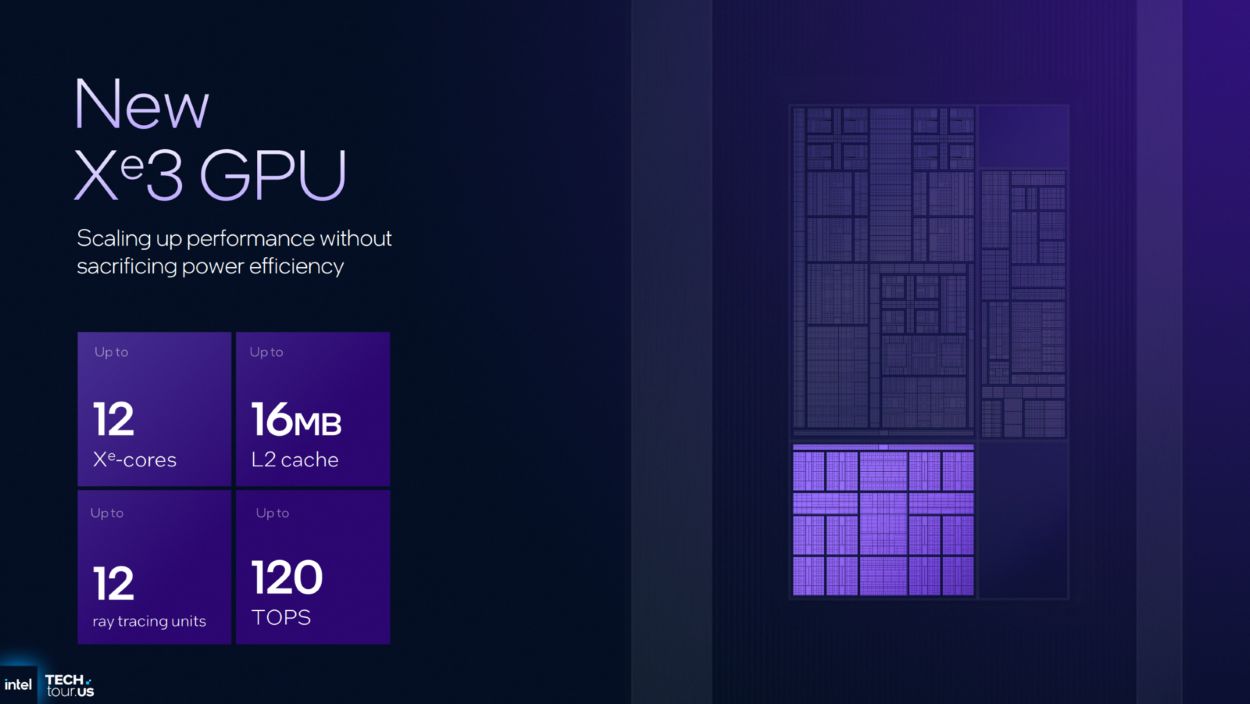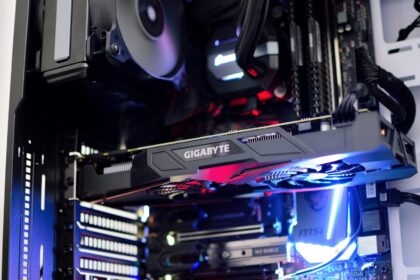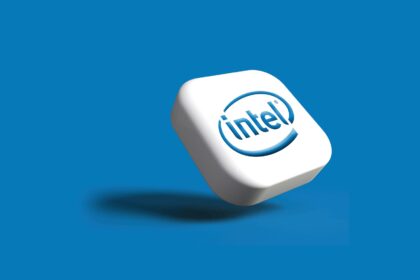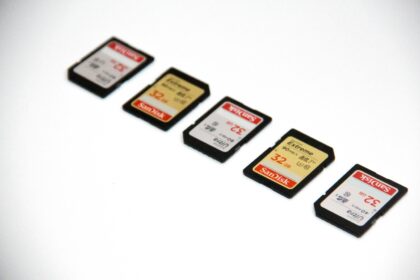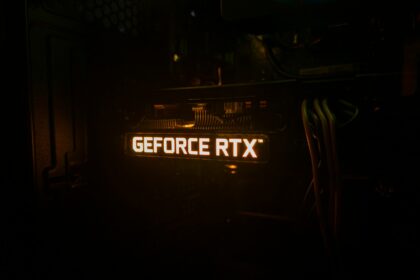Intel just revealed the most ambitious integrated graphics upgrade in years. The new Xe3 architecture inside upcoming Panther Lake processors could finally make discrete graphics cards unnecessary for many laptop users. With up to 12 Xe3 cores and revolutionary AI-powered frame generation, Intel is throwing down the gauntlet against both AMD and Nvidia.
The numbers that matter most
Panther Lake’s flagship Xe3 GPU configuration delivers a massive 50% performance increase over Lunar Lake. That’s not just marketing speak – Intel is doubling down with actual architectural improvements that make every clock cycle count. The new design features up to 12 Xe3 cores compared to Lunar Lake’s 8 cores, representing a 50% increase in raw compute power.
But the improvements go far deeper than just adding more cores. Each Xe3 core gets a 33% larger L1 cache and enhanced shared local memory. The total L2 cache has doubled from 8MB to 16MB in the flagship configuration. This massive cache increase reduces memory traffic by up to 36% compared to previous designs.
“Intel confirmed that Panther Lake’s iGPU can feature up to 12 Xe3 cores, up from 8 Xe2 cores in Lunar Lake—a 50% increase in core count—but the company isn’t relying on raw scale alone: it claims more than 50% faster graphics performance versus Lunar Lake”, according to technical specifications shared by Intel.
Revolutionary AI-powered frame generation arrives
Intel’s new XeSS Multi-Frame Generation (MFG) technology can create up to three artificial frames between each rendered frame. This means your laptop could display four times as many frames as the GPU actually renders. The technology works similarly to Nvidia’s DLSS 4, but Intel promises it will work on older Arc hardware too.
The demo results are impressive. A game running at 30 frames per second natively can appear to run at 120 fps with 4x frame generation enabled. Intel showed off the upcoming Painkiller reboot running at around 150 fps on pre-production Panther Lake hardware, with the GPU only rendering about 30-40 of those frames.
Frame generation isn’t magic though. It adds some input latency because the system needs to know what the next frame looks like before generating the in-between frames. Intel combats this with XeLow Latency (XeLL) technology that minimizes the delay to around 5 milliseconds compared to an industry average of 15ms.
Architectural improvements across the board
Intel redesigned almost every aspect of the Xe3 architecture for better efficiency and performance. Each render slice now contains six Xe3 cores instead of four in Xe2. The vector engines can handle 25% more threads thanks to a new variable register allocation system that dynamically balances workloads.
Ray tracing performance gets a major boost too. Intel claims 2x faster ray-triangle intersection performance and improved thread sorting to prevent pipeline bottlenecks. The company also doubled anisotropic filtering rates and stencil test performance, which directly impacts visual quality in games.
The improvements show up in Intel’s internal benchmarks. Depth writing operations are up to 7.4x faster, while mesh rendering sees a 2.4x speedup. These aren’t small tweaks – they represent fundamental improvements to how the GPU processes graphics workloads.
“According to internal metrics, Xe3 doubles anisotropic filtering and stencil test rates, doubles ray–triangle intersection performance, delivers 2.4× faster mesh rendering, and can achieve up to 7.4× faster depth writes”, Intel detailed in their technical presentations.
The 18A manufacturing advantage
Panther Lake represents Intel’s first major consumer product built on their cutting-edge 18A process node. This 2-nanometer class technology is the most advanced manufacturing process developed and manufactured in the United States. The new process provides up to 15% better performance per watt through denser transistors and improved power delivery.
The 18A node introduces two revolutionary technologies: RibbonFET gate-all-around transistors and PowerVia backside power delivery. These innovations increase transistor density by up to 30% while improving power efficiency. For mobile devices, this translates directly into longer battery life and cooler operation.
Intel is manufacturing Panther Lake at their Fab 52 facility in Arizona, marking a significant step in bringing advanced chip production back to American soil. The facility is fully operational and ramping up to high-volume production for the first customer shipments later this year.
AI acceleration reaches new heights
Panther Lake’s AI capabilities extend far beyond frame generation. The complete system can deliver up to 180 TOPS (trillion operations per second) when combining the GPU, NPU, and CPU. That’s 50% more AI performance than Lunar Lake and 400% more than Arrow Lake.
The Xe3 GPU alone contributes up to 120 TOPS of AI performance through its XMX matrix engines. This puts integrated graphics within striking distance of entry-level discrete GPUs for AI workloads. The increased AI muscle supports Intel’s vision of “agentic PCs” that handle language models and AI assistants locally without cloud dependence.
For content creators and professionals, this AI acceleration opens up new possibilities. Video editing, 3D rendering, and creative workflows can leverage on-device AI processing for faster results and better privacy. The system can handle complex AI tasks while preserving battery life for mobile productivity.
Gaming performance that challenges discrete GPUs
Intel’s internal testing shows Panther Lake achieving desktop-class gaming performance in popular titles. In Cyberpunk 2077 at 1080p high settings, Arrow Lake managed 45 fps while Panther Lake jumped to 90 fps with much richer visual details. That’s exactly double the performance while using similar power levels.
The improvements aren’t limited to raw frame rates. Intel emphasizes “consistent performance” as a key goal for Xe3. Previous Arc GPUs struggled with frame-time consistency, leading to stuttering and uneven gameplay. The new architecture addresses these issues through better resource utilization and smarter workload management.
For handheld gaming devices, these improvements could be game-changing. The combination of higher performance and better efficiency makes Panther Lake ideal for portable gaming systems that need to balance performance with battery life and thermal constraints.
Competing directly with AMD’s mobile dominance
AMD’s Radeon mobile graphics have dominated the integrated GPU market for years. Their latest Ryzen AI processors with RDNA 3.5 graphics provide strong performance in thin-and-light laptops and handheld gaming devices. Panther Lake represents Intel’s most serious challenge to AMD’s mobile graphics leadership.
Early comparisons suggest Panther Lake’s 12 Xe3 configuration could match or exceed AMD’s best integrated graphics in many scenarios. The addition of mature frame generation technology gives Intel a significant advantage, as AMD currently lacks a comparable multi-frame generation solution.
The competition extends beyond raw performance to software support and driver maturity. Intel has invested heavily in Arc driver development and game optimization following the lessons learned from their discrete GPU launch. This software focus should translate into better real-world gaming experiences.
The software ecosystem advantage
Intel’s XeSS technology now supports GPUs from multiple vendors, not just Intel hardware. With the release of XeSS 2.1, even Nvidia GeForce and AMD Radeon users can benefit from Intel’s AI upscaling and frame generation technologies. This cross-platform approach helps build developer support and user adoption.
The company has also improved their development tools and documentation. XeSS SDK provides developers with easy integration paths for upscaling, frame generation, and latency reduction. Better developer support typically translates into broader game compatibility and more stable performance.
Intel’s graphics software team has addressed many of the compatibility issues that plagued early Arc products. Regular driver updates and game-specific optimizations show Intel’s commitment to supporting their graphics hardware long-term.
Real-world implications for laptop buyers
Panther Lake could eliminate the need for discrete graphics in many laptop categories. Content creators, casual gamers, and even some enthusiasts might find integrated graphics sufficient for their needs. This simplifies laptop design, improves battery life, and reduces costs.
The technology particularly benefits ultrabooks and thin-and-light laptops where discrete graphics create thermal and power challenges. Users could enjoy smooth 1080p and even 1440p gaming without the compromises typically associated with discrete GPU laptops.
However, the technology isn’t perfect. Frame generation works best when the base frame rate is already reasonable – typically above 30-45 fps. Users trying to play demanding games at very low base frame rates may experience visual artifacts or increased input latency that makes the technology less appealing.
The competitive landscape shifts
Panther Lake’s arrival forces both AMD and Nvidia to respond with their own innovations. AMD is rumored to be working on their own multi-frame generation technology, while Nvidia continues pushing DLSS advancement. This competition benefits consumers through faster innovation cycles.
The integrated graphics market is becoming increasingly important as discrete GPU prices remain high. Many users are realizing that integrated graphics can handle their gaming and creative needs without the cost and complexity of discrete cards.
Intel’s success with Panther Lake could also impact the handheld gaming market currently dominated by AMD-powered devices. If Intel can deliver comparable performance with better efficiency and advanced features like frame generation, device manufacturers have a compelling alternative.
Production timeline and availability
Panther Lake processors are already in production at Intel’s Arizona facility. The company expects to begin shipping the first SKUs before the end of 2025, with broad market availability starting in January 2026. CES 2026 will likely serve as the official launch venue for Panther Lake laptops.
Intel plans to brand these processors as Core Ultra Series 3, continuing the naming convention established with Meteor Lake and Lunar Lake. Multiple configurations will be available, from low-power variants with 4 Xe3 cores to high-performance models with the full 12-core GPU.
The production ramp represents a significant milestone for Intel’s foundry business. Successfully manufacturing Panther Lake demonstrates Intel’s ability to compete with TSMC on advanced process nodes while keeping production in the United States.
Looking toward the future
Panther Lake represents more than just a generational upgrade – it’s Intel’s statement of intent for the future of computing. The combination of powerful integrated graphics, advanced AI acceleration, and cutting-edge manufacturing shows Intel’s commitment to challenging the status quo.
The success of Panther Lake will largely determine Intel’s credibility in mobile computing for years to come. If the architecture delivers on its promises, Intel could reclaim significant market share from AMD in laptops and potentially establish a foothold in handheld gaming.
Beyond immediate performance benefits, Panther Lake establishes the foundation for future Intel architectures. The lessons learned from 18A manufacturing and Xe3 graphics will inform next-generation products across Intel’s entire portfolio.
“Panther Lake literally merges the power efficiency of Lunar Lake with the performance of Arrow Lake within a product family, utilizing Intel 18A to integrate these architectures”, stated Intel’s Jim Johnson, highlighting the strategic importance of this platform for Intel’s future success.


